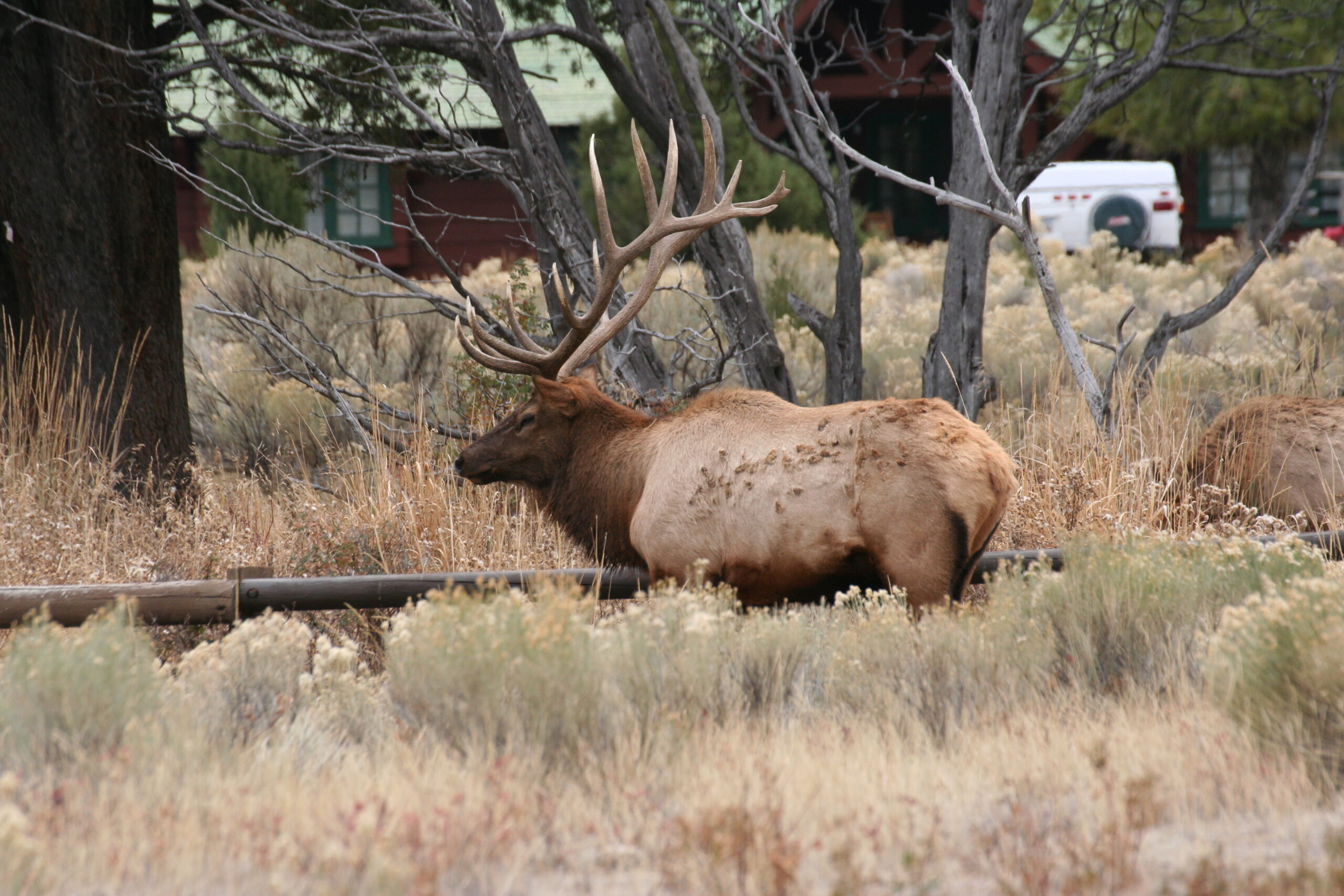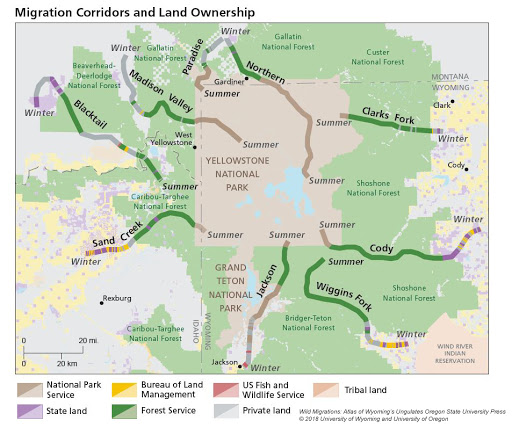Statement submitted to the U.S. House Committee on Natural Resources – Subcommittee on Water, Oceans, and Wildlife Hearing on H.R. 2795, “Wildlife Corridors Conservation Act of 2019,” on October 17, 2019.
Main Points
- Conserving migration corridors is essential to the conservation of America’s wildlife heritage.
- Wildlife often migrate and disperse across private lands, which provide essential habitat for many migratory species.
- As Congress explores ways to conserve migration corridors, it should carefully consider the important role that private landowners play in providing critical habitat for migratory species and find ways to help them better address the challenges of living with wildlife.
Introduction
Distinguished members of the House Natural Resources Committee, thank you for the opportunity to submit this written statement for the hearing record on the Wildlife Corridors Conservation Act of 2019. The stewardship of wildlife corridors through market-based solutions is a priority issue for the Property and Environment Research Center (PERC), a conservation research institute based in Bozeman, Montana. PERC has a nearly 40-year history dedicated to exploring market-based solutions to conservation challenges, including ways to make wildlife an asset, or less of a liability, for the people who directly live with them. We are currently engaged in a multi-year research initiative on corridor conservation that draws upon the strengths of our network of researchers and our relationships with landowners in Montana and across the West.
Conserving migration corridors is essential to the conservation of our wildlife heritage. Proactively addressing the changing problems facing wildlife habitat means we can devise creative and sustainable solutions to promote healthy animal populations and biodiversity. As the Subcommittee on Water, Oceans, and Wildlife prepares to discuss H.R. 2795, the “Wildlife Corridors Conservation Act of 2019,” we encourage you to consider the vital role of private working lands in wildlife migrations.
Migrating and dispersing wildlife often depend on private lands for habitat, especially on agricultural and timber lands. In the West, for example, large ungulates such as elk and mule deer are highly dependent on winter range found on low-elevation private farms and ranches. Yet the presence of wildlife can negatively impact the livelihoods of private landowners who are so essential in providing the public benefit of healthy wildlife populations. To truly protect migration corridors, we need to address the challenges that come with living with wildlife so that private landowners do not shut their gates to wildlife.
Conserving wildlife migration corridors is essential to the conservation of America’s wildlife heritage.
For many species, migration is essential to their survival. They travel through landscapes and across boundary lines to find food, habitat, and favorable climates. Many species in the United States, ranging from fish to birds to large mammals, migrate in response to seasonal or spatial distribution of resources.
By making these voyages for survival, migratory animals can act as pollinators and seed distributors or serve as a food source for other wildlife species. Alaskan grizzly bears, for example, depend on the many spawning salmon that travel upriver from the oceans to survive winter hibernation. Here in Montana, migratory elk provide not only food for predators but also recreational opportunities for the region’s many ecotourists and food for local residents.
Yet habitat loss, human-wildlife conflicts, and changing climates threaten many wildlife migration corridors. Land conversion, poorly planned residential development, and wildlife-to-livestock disease transmission are potential threats to migration corridors in the Greater Yellowstone Ecosystem. If we hope to preserve America’s wildlife heritage, we should be proactive in protecting these migratory paths.
Wildlife often migrate and disperse across private lands, which provide essential habitat for many migratory species.
PERC is fortunate enough to be headquartered in the Greater Yellowstone Ecosystem, a region often thought of as the wildest place in the continental United States. The mix of public and private lands in the region allows us to see first-hand how each supports the other. It also allows us to bear witness to the important role that private lands play in conserving the region’s herds of elk, pronghorn, and other wildlife that rely on private lands for as much as 80 percent of their winter range.[1]
One migration that illustrates the critical role that private landowners play in conservation is that of the Northern Yellowstone Elk Herd. With nearly 7,600 animals, the herd is the largest grouping of ungulates in Yellowstone National Park. The herd spends the summer in high meadows along the northern border of the park.
When snow covers the once-nutritious grasses at high elevations in early fall, elk migrate down to still-green valleys. A subset of the Northern Yellowstone Herd, known as the Paradise Valley Herd, eventually makes its way out of Yellowstone National Park to large stretches of private ranches that dominate the valley north of the park that gives the herd its name.
Some of the elk that winter in the Paradise Valley travel as far as 125 miles to reach their winter range in the valley’s grasslands, where over 90 percent of the land is privately owned.[2] This movement is possible only because of the landowners whose land management practices have kept the corridor undeveloped through good stewardship, working ranches, and partnerships with conservation organizations. This stewardship has helped stabilize the herd’s population over the past 19 years, after the population plummeted following the 1995 reintroduction of wolves to Yellowstone National Park and both drought and extreme winter weather began to grip the region.[3]
These agricultural lands have been critical to elk survival over recent harsh winters when elk sought forage on ranches in the valley’s lowest elevations. Even with the respite offered in the valleys, elk mortality was higher than previous years. In 2019, Montana Fish Wildlife and Parks counted 23 percent fewer elk than the year before.[4] Were these private lands not available, however, it is possible that declines may have been catastrophic.
As Congress explores ways to conserve migration corridors, it should carefully consider the important role that private landowners play in providing critical habitat for migratory species and find ways to help them better address the challenges of living with wildlife.
Migrating wildlife often depend on habitat provided on private lands, but their presence can negatively impact the livelihoods of the landowners. At the same time, landowners are often unrecognized and under-supported for the costs they shoulder in providing the public with the benefit of healthy wildlife populations.
Programs aimed at conserving wildlife corridors will be more successful if they help landowners address the costs associated with living with wildlife on private lands. Too often, these costs are overlooked by conservation managers, activists, or members of Congress, yet they can be substantial and undermine the long-term viability of both working lands and migratory pathways.
In the Greater Yellowstone Ecosystem, one of the most significant impacts associated with migratory wildlife—especially elk—is the risk of brucellosis transmission. Brucellosis is a highly contagious disease that can cause cattle to abort or give birth to weak calves that are unlikely to live. The Greater Yellowstone Region is the last repository of the disease in North America, where it is carried by both elk and bison.
Though instances of elk infecting cattle with brucellosis are rare, the risks weigh heavily on ranchers. Vaccinations are only about 70 to 80 percent effective, and combinations of increased predator populations, changing hunting dynamics between public and private lands, snowfall variation, and human development push higher concentrations of elk into contact with cattle as they compete for the same forage.[5] The Northern Yellowstone Herd’s rate of brucellosis infection has also increased in recent years, further heightening the risk of cross-infection as the herd comes into contact with livestock.
If brucellosis is found in cattle, the entire herd must be quarantined for over six months, until each animal tests negative for the disease, costing an estimated $140,000 for a herd of 400 head.[6] Another option is to “depopulate,” or destroy, all of the bulls and heifers in a herd. Either of these options can spell financial ruin for a rancher. In addition, the federal government can place trade restrictions on an entire state’s cattle industry—even herds not infected— if a brucellosis outbreak occurs.
Migratory ungulates also compete with cattle for food. While specific numbers are currently unknown, the Montana Department of Fish, Wildlife and Parks has previously calculated the annual financial losses to landowners stemming from lost forage, lost hay, and property damage due to wildlife to be over $30 million.[7] Efforts to offset this damage by compensating ranchers cost taxpayers an additional $1.5 million between 2010 and 2014.[8]
Conclusion
It is critical that efforts to conserve migration corridors transform wildlife from an economic liability into an asset for the private landowners who provide essential habitat. Corridors on federal land begin and end somewhere, and more often than not it is on private land. Lines on a map can be concerning to landowners who won’t necessarily see federal interest in migration corridors as a good thing. Corridor designations should respect private property rights and not impose regulatory burdens on landowners. By respecting private property rights and using economic incentives in place of regulation, conservation efforts will better engage more landowners.
The great conservationist Aldo Leopold noted in his treatise Conservation Economics that “conservation will ultimately boil down to rewarding the private landowner who conserves the public interest.”[9] Conserving migration corridors requires that landowners be engaged on their terms and that conservation be practiced in a way that creates benefits, or at least does not add to burdens, associated with the presence of wildlife on private land. Solutions and incentives should be bottom up, and the landowner’s perspective should have more of a voice in the process of conserving corridors.
[1] “Protecting Elk Migration in the Greater Yellowstone Ecosystem.” National Geographic.
[2] Gardiner Quadrangle – 45110a, Private Land Ownership Identification. Map. Montana Fish, Wildlife & Parks and Montana State Library Geographic Information. September 2016.
[3] “Famous Yellowstone Elk Herd Rebounds Two Decades After Wolf Reintroduction,” by Brett French. Casper Star Tribune. February 3, 1028.
[4] “2019 Late Winter Survey of Northern Yellowstone Elk.” National Park Service. April 4, 2019.
[5] “Facts About Brucellosis.” U.S. Department of Agriculture, Animal and Plant Health Inspection Service.
[6] “Economic Costs of Brucellosis,” by Dannele Peck and Bryan Wilson. Wyoming Brucellosis Coordination Team Meeting, April 13, 2016. Pinedale, Wyoming.
[7] “The Contributions of Landowners to Big Game in Montana,” by Jim Knight and Carolyn Nistler. Montana State University Extension. 2007.
[8] “Performance Audit: Game Damage Program – Department of Fish, Wildlife and Marks.” Montana Legislative Audit Division. 14P-06. May 2015.
[9] “Conservation Economics” in The RIver of the Mother of God and Other Essays, by Aldo Leopold. Edited by Susan L. Flader and J. Baird Callicott. University of Wisconsin Press. 1991.





